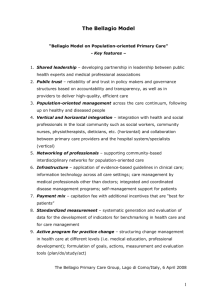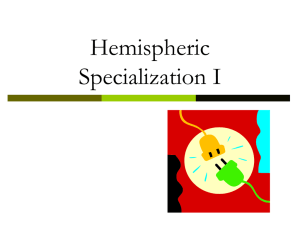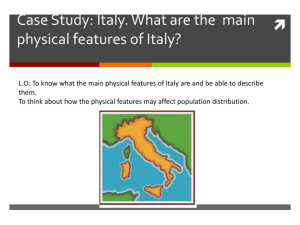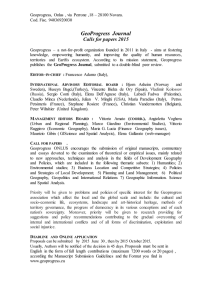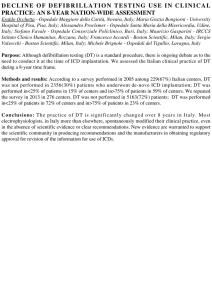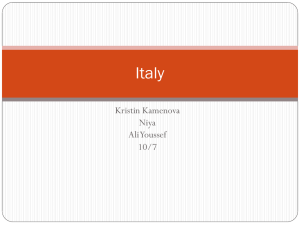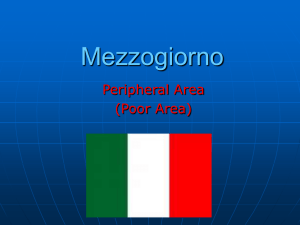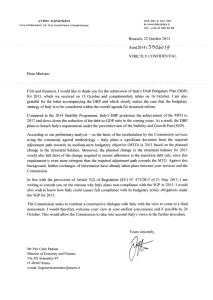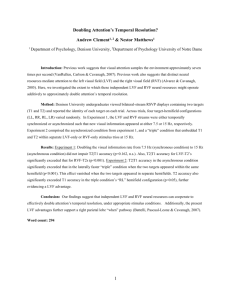Stakeholders in Climate Sensitive Diseases
advertisement
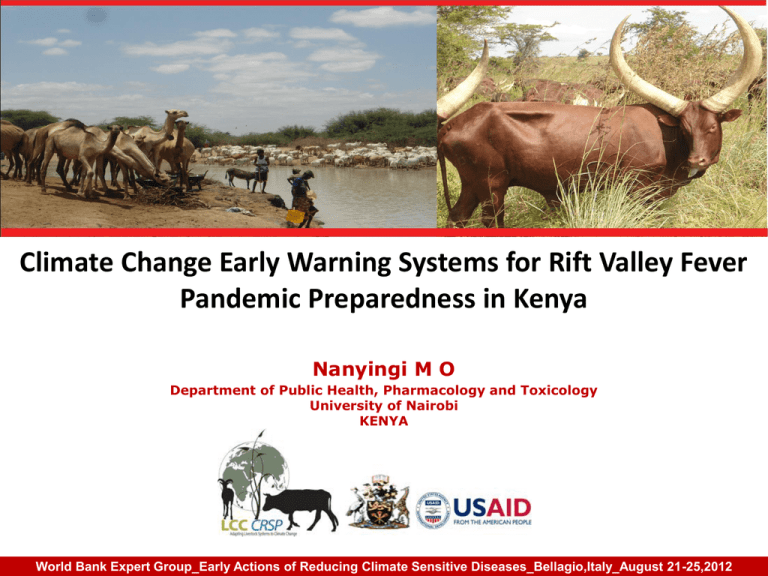
Climate Change Early Warning Systems for Rift Valley Fever Pandemic Preparedness in Kenya Nanyingi M O Department of Public Health, Pharmacology and Toxicology University of Nairobi KENYA World Bank Expert Group_Early Actions of Reducing Climate Sensitive Diseases_Bellagio,Italy_August 21-25,2012 Climate Change Impacts in Kenya In 2006 and 2007, PH Burden of RVF OB resulted in 3.4 DALYs per 1000 people and household costs of about Ksh 10,000 (USD120) 3%GDP loss $500M/(2012) $1-2 B(2030) 2 World Bank Expert Group_Early Actions of Reducing Climate Sensitive Diseases_Bellagio,Italy_August 21-25,2012 Disease Early Warning Systems (DEWS) MEWS (MODIS_NDVI) HEALTH MAPPER Are these tools available universally and utilized adequately? World Bank Expert Group_Early Actions of Reducing Climate Sensitive Diseases_Bellagio,Italy_August 21-25, 2012 RVF Contingency plans for EWS in Kenya (ongoing) Linkage with communities to monitor climatic parameters. Precipitation ,flooding and mapping of “dambos” Remote sensing and GIS data(NDVI of 0.43-0.45/ SST by 0.5 degrees ) epidemic indicative Community-Based Early Warning System (CB-LEWS) DVS trains communities to capture data relevant for RVF early warning. Monitoring of vector Dynamics and virus activity in sentinel herds? Farmer and public Communications Officer. awareness programmes by Veterinary Community radios ,flyers and mobile phones for preparedness. World Bank Expert Group_Early Actions of Reducing Climate Sensitive Diseases_Bellagio,Italy_August 21-25, 2012 Stakeholders in Climate Sensitive Diseases Government Veterinary ,Public Health, Agriculture,Met Universities,Research Institutions Vulnerable Communities CAPACITY BUILDING Risk Assessment Lab Diagnosis Information MS Simulation Exercise ONE HEALTH COORDINATION DISEASE CONTROL Community Sentinel Surveillance Vaccinations and Vector Control COMMUNICATION System Appraisal strategy Participatory message devt (FGD) Media Engagement(Radio, TV) World Bank Expert Group_Early Actions of Reducing Climate Sensitive Diseases_Bellagio,Italy_August 21-25, 2012 Research: RVF Spatiotemporal Epidemiology Participatory Epidemiology: Rural appraisal and Community EWS to RVF investigated. Sero-monitoring of sentinel herds and Geographical risk mapping of RVF hotspots? Trans-boundary Surveillance for secondary foci(Neighboring country) Disease burden Analysis and predictive modeling Decision support tools for community utilization(Risk maps, brochures, radio and video clips) World Bank Expert Group_Early Actions of Reducing Climate Sensitive Diseases_Bellagio,Italy_August 21-25, 2012 Community Involvement Disease surveillance Committees (Animal health workers +Livestock keepers + Veterinary /Public health officers) Community mapping of watering Points/Dams or “Dambos” Training of trainers(TOT) on EWS Information feedback mechanisms ( Schools, churches, village meetings) Tran-sboundary security committees World Bank Expert Group_Early Actions of Reducing Climate Sensitive Diseases_Bellagio,Italy_August 21-25, 2012 RVF Monitoring and Surveillance -Community Model e-surveillance Aanansen et al., 2009, Madder et al., 2012 Community sensitization/awareness by Syndromic surveillance (Mobile phones) Dissemination of Information through community vernacular radio,SMS World Bank Expert Group_Early Actions of Reducing Climate Sensitive Diseases_Bellagio,Italy_August 21-25, 2012 Communication tools : Risk Maps of RVF in Kenya Bett et al.,2012 Is there Geographical restriction of the Diseases? What other factors are involved in endemicity of RVF? World Bank Expert Group_Early Actions of Reducing Climate Sensitive Diseases_Bellagio,Italy_August 21-25, 2012 Further secondary data analysis for RVF prediction Precipitation and Temperature from the Kenya Meteorological Department/ECMWF for time series analysis (2000-2011) Sero-prevalence and inter-epidemic estimates of RVF from the Department of Veterinary Services. Disease burden analysis using demographics from Human National Census Vegetative Index (NDVI) and Soil type cover for suitability of vector analysis. Process based geographical risk modeling and Linear regression analysis for RVF distribution World Bank Expert Group_Early Actions of Reducing Climate Sensitive Diseases_Bellagio,Italy_August 21-25, 2012 Outbreak Maps of RVF in Kenya –(1912-2010) Response targeted. can be geographically Vaccine allocation and distribution is site specific(cost saving mechanism) Secondary foci of outbreaks in semiurban locations. Controlled Bett et al.,2012 Human and Animal migration to curb the spread of climate sensitive diseases Post Vaccination sero-monitoring( AVID) World Bank Expert Group_Early Actions of Reducing Climate Sensitive Diseases_Bellagio,Italy_August 21-25, 2012 Climate EWS Caveats in Kenya Lack of capacity and expertise to contextualize climate change sensitive disease predictions and scenarios. Dysfunctional communication channels (Technological inadequacies in rural communities) Transboundary armed conflicts (Pastoral cattle rustling) Financial Constraints in Climate Change Research(Parsimony??) Ethno-Religious Barriers Ineffective Lack of government policies on climate sensitive Diseases efficient infrastructure(roads, electricity) World Bank Expert Group_Early Actions of Reducing Climate Sensitive Diseases_Bellagio,Italy_August 21-25, 2012 Beneficiaries of Climate Early Risk Assessment Government ministries Affected Communities Non Govt. Partners Research institutes Schools Universities Donors (Data) Sustainable planning and decision making tools to support the development of appropriate climate change adaptation and mitigation policies. Simulation exercises to test response to RVF epizootic and strengthen working between veterinary, medical, and entomological sectors. World Bank Expert Group_Early Actions of Reducing Climate Sensitive Diseases_Bellagio,Italy_August 21-25, 2012 Contributions to EWS in Kenya: Stakeholders Capacity and Networks Zoonoses Working Group has been established (One Health concept).-CDC Linking expert institutions through global networks within both the animal and health sectors Improvements in governance, infrastructure and capacity building will also prove valuable to secure the livelihoods of vulnerable populations. Participatory approaches : Farmer Field Schools and livestock owners’ training on climate change for zoonoses preparedness and prevention. Improved surveillance, early detection and timely diagnosis, transparency of animal disease information Rapid response to outbreaks as well as the potential use of the network approach in providing data for studies related to climate sensitive diseases. World Bank Expert Group_Early Actions of Reducing Climate Sensitive Diseases_Bellagio,Italy_August 21-25, 2012 Acknowledgements Data and Financial Support Contributing Authors Bett B, International Livestock Research Institute, Kenya Thumbi SM, Edinburgh, UK University of Project Advisors Kiama SG, Wangari Maathai Institute, University of Nairobi Muchemi GM, Department of Public Health, Pharmacology and Toxicology University of Nairobi World Bank Expert Group_Early Actions of Reducing Climate Sensitive Diseases_Bellagio,Italy_August 21-25, 2012
